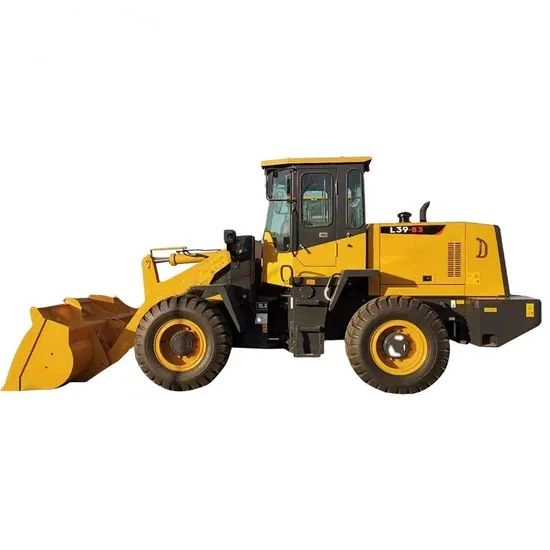Wheel loaders are common mechanical equipment in engineering construction. Their working environment is complex, and improper operation can easily lead to safety accidents. The following details the key points of safe operation of wheel loaders from three stages: before operation, during operation, and after operation:

- Appearance inspection: Check whether the vehicle body is damaged, whether the tire pressure is normal, whether the wear is uniform, and whether the wheel hub bolts are tight; Check whether the glass and rearview mirrors are intact and clear, and whether the lights (turn signals, headlights, warning lights, etc.) can work normally.
- Core component inspection: Check whether the engine oil, fuel, and coolant are sufficient and whether there is any leakage; Inspect the hydraulic system, including the hydraulic oil level, whether the hydraulic pipeline connections are firm, whether there is oil leakage, and whether the hydraulic pump and hydraulic motor work normally; Check the braking system to ensure that the service brake and parking brake are sensitive and reliable, and that the brake fluid volume meets the requirements.
- Operating device inspection: Check the stroke and flexibility of the joysticks and pedals to ensure that they can normally control the loader's driving, steering, shoveling, and other actions.
Site preparation: Clear obstacles in the operation site, such as stones, debris, wires, etc., to ensure that the operation area is flat and solid; Clarify the operation scope and driving route to avoid cross-operation with other equipment and personnel; Set up warning signs in dangerous areas, such as "No Entry" and "Caution".
Personnel preparation: Operators must receive professional training, be familiar with the performance, structure, and operation methods of wheel loaders, and obtain corresponding operation qualification certificates before taking up their posts; Wear personal protective equipment before operation, such as safety helmets, work clothes, work shoes, gloves, etc. It is strictly forbidden to work in slippers, high heels, or bare-chested.
- When starting the engine, first put the gear lever in the neutral position, pull up the parking brake lever, and then operate according to the engine starting steps; After starting, let the engine idle for 3-5 minutes, and start working after the engine water temperature and oil temperature reach the normal range.
- When driving, abide by traffic rules, maintain a safe speed, and avoid overspeeding; Use high gear when driving on flat roads, and low gear when driving on rough roads or climbing slopes; When turning, slow down in advance, honk to indicate, and avoid sharp turns and sudden braking.
- During driving, always observe the road conditions ahead and the surrounding environment, and pay attention to avoiding pedestrians, vehicles, and obstacles; It is strictly forbidden to carry out shoveling operations or adjust the bucket position while driving.
- When shoveling materials, select the appropriate bucket position and shoveling angle according to the nature of the materials and the loading capacity; When lowering the bucket, operate slowly to avoid hitting the ground; When shoveling materials, insert the bucket into the bottom of the materials, then slowly lift the bucket and retract the bucket at the same time to fill the bucket with materials.
- When loading materials, park the loader steadily next to the unloading point, pull up the parking brake lever, then slowly lift the bucket and unload the materials into the transport vehicle or designated place; When unloading, pay attention to observing the surrounding environment of the unloading point to avoid materials spilling and hurting people or damaging equipment.
- Overloading is strictly prohibited, and the loading capacity shall not exceed the rated load capacity of the loader; It is strictly forbidden to shovel materials exceeding the bucket volume to avoid affecting the stability and safety of the loader.
- When the loader is trapped in mud, potholes, or other predicaments, do not drive force;take measures such as padding soil or stones to drive the loader out of the predicament; It is strictly forbidden to use the bucket to pry the loader or other objects to avoid damaging the equipment.
- During the operation, if the equipment is found to have abnormal noise, vibration, oil leakage, etc., stop the operation immediately, check and eliminate the cause of the fault before continuing the operation.
- When working on a slope, take anti-skid measures, such as placing stones or wooden boards under the wheels; It is strictly forbidden to park or turn off the engine on a slope. If parking is necessary, pull up the parking brake lever and place blocks under the wheels.
Equipment parking: After the operation, park the loader on a flat and solid site, pull up the parking brake lever, put the gear lever in the neutral position, and turn off the engine; Lower the bucket to the ground to avoid hanging it in the air; Clean up the residual materials in the bucket to keep the equipment clean.
Equipment inspection and maintenance: Check whether the core components such as the engine, hydraulic system, and braking system have leakage, damage, etc. If there is any problem, repair them in time; Check whether the bolts and nuts of all parts are tight, and tighten them in time if they are loose; Clean the dust, oil, and other debris on the surface of the equipment to keep it clean.
Recording and reporting: Record the equipment operation status, operation time, loading capacity, and other information during the operation; If major faults or potential safety hazards are found in the equipment, report them to the relevant person in charge in time and take corresponding measures to deal with them.
In conclusion, the safe operation of wheel loaders requires operators to strictly abide by the operating procedures, and do a good job in preparation before operation, operation during operation, and maintenance after operation, so as to ensure the safe operation of the equipment and the personal safety of the operators.






